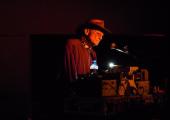Year Out/Year In: Electronic Music Digs In and Spreads Out

A year of tumult, generational shift and technicolour brilliance in clubland
2010 saw some major shifts stirring up the UK club music ecosystem and unleashing some fascinating hybrids and variants of existing sounds out into the wild. As the hefty bass of dubstep muscled its way firmly into the heart of the mainstream, everything else was forced to rearrange its position, with some surprising results.









